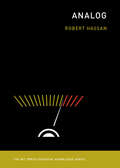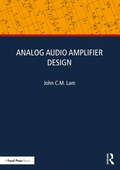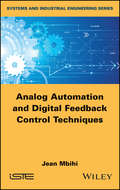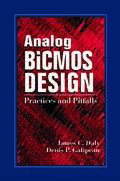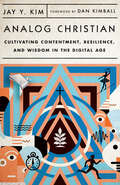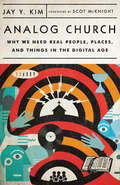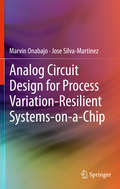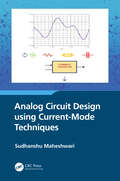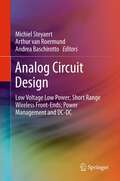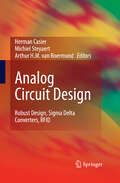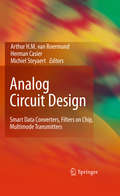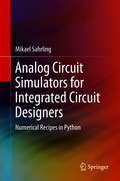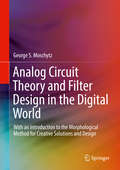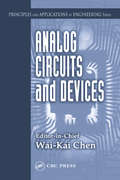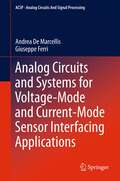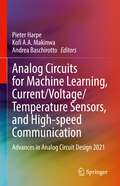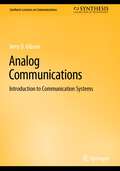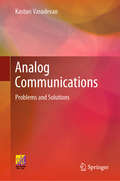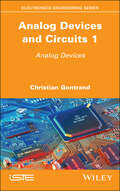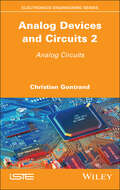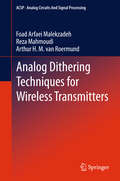- Table View
- List View
Analgesia: Methods and Protocols (Methods in Molecular Biology #617)
by Arpad SzallasiChronic pain is a complex phenomenon, which continues to remain undertreated in the majority of affected patients thus representing a significant unmet medical need, but the development of cellular, subcellular, and molecular methods of approaching this epidemic of pain shows great promise. In Analgesia: Methods and Protocols, experts in the field present thorough coverage of molecular analgesia research methods from target discovery through target validation and clinical testing to tolerance and dependence, with extensive chapters on emerging receptor classes as targets for analgesic drugs and innovative analgesic strategies. As a volume in the highly successful Methods in Molecular BiologyTM series, the chapters include introductions to their respective topics, lists of the necessary materials and reagents, step-by-step, readily reproducible protocols, and notes sections with tips on troubleshooting and avoiding known pitfalls. Comprehensive and essential, Analgesia: Methods and Protocols promises to aid and enrich the research of all those scientists and clinicians who are interested in what the increasingly molecular future has in store for analgesia research, from the molecular research bench through the animal laboratory to the bedside.
Analise
by Lisa GregoryA STORMY SURRENDER TO LOVE... He swept down from the North, disguised as a Confederate officer, determined to woo the belle of New Orleans, Analise Caldwell-and wrest from her the military secrets her father held. Now, to save a life, the raven-haired Analise must trade her innocence to this Union spy and major, the iron-willed Mark Schaeffer, the man who treats her like pirate booty and possesses her with a jealous fury. Torn from family and friends, burning with a tenderness she dare not speak, the spirited beauty must survive in a battle-scarred world and fight for the tempestuous love of her captor. For Analise has imprisoned the wild heart of her Yankee foe...and although the city of Spanish moss and French elegance has surrendered -the war of flame-bright passions has just begun...
Analog (The MIT Press Essential Knowledge series)
by Robert HassanWhy, surrounded by screens and smart devices, we feel a deep connection to the analog—vinyl records, fountain pens, Kodak film, and other nondigital tools.We&’re surrounded by screens; our music comes in the form of digital files; we tap words into a notes app. Why do we still crave the &“realness&” of analog, seeking out vinyl records, fountain pens, cameras with film? In this volume in the MIT Press Essential Knowledge series, Robert Hassan explores our deep connection to analog technology. Our analog urge, he explains, is about what we&’ve lost from our technological past, something that&’s not there in our digital present. We&’re nostalgic for what we remember indistinctly as somehow more real, more human. Surveying some of the major developments of analog technology, Hassan shows us what&’s been lost with the digital. Along the way, he discusses the appeal of the 2011 silent, black-and-white Oscar-winning film The Artist; the revival of the non-e-book book; the early mechanical clocks that enforced prayer and worship times; and the programmable loom. He describes the effect of the typewriter on Nietzsche&’s productivity, the pivotal invention of the telegraph, and the popularity of the first televisions despite their iffy picture quality.The transition to digital is marked by the downgrading of human participation in the human-technology relationship. We have unwittingly unmoored ourselves, Hassan warns, from the anchors of analog technology and the natural world. Our analog nostalgia is for those ancient aspects of who and what we are.
Analog Audio Amplifier Design
by John C.M. LamAnalog Audio Amplifier Design introduces all the fundamental principles of analog audio amplifiers, alongside practical circuit design techniques and advanced topics. Covering all the basics of amplifier operation and configuration, as well as high-end audio amplifiers, this is a comprehensive guide with design examples and exercises throughout. With chapters on single-device, operational, multi-stage, voltage buffer, power, line-stage and phono-stage amplifiers, Analog Audio Amplifier Design is a comprehensive and practical introduction that empowers readers to master a range of design techniques. This book also provides a variety of graphs and tables of key amplifying devices and properties of amplifier configurations for easy reference. This is an essential resource for audio professionals and hobbyists interested in audio electronics and audio engineering, as well as students on electrical and audio engineering courses.
Analog Automation and Digital Feedback Control Techniques
by Jean MbihiThis book covers various modern theoretical, technical, practical and technological aspects of computerized numerical control and control systems of deterministic and stochastic dynamical processes.
Analog BiCMOS Design: Practices and Pitfalls
by James C. Daly Denis P. GalipeauIntegrated circuits (ICs) don't always work the first time. Many things can and do go wrong in analog circuit designs. There are a number of common errors that often require costly chip redesign and refabrication, all of which can be avoided when designers are aware of the pitfalls. To realize success, IC designers need a complete toolbox-a toolbox filled not only with a solid background in electronics, design concepts and analysis skills, but also with the most valuable tool of all: experience. Analog BiCMOS Design offers IC design engineers the learning equivalent to decades of practical experience. Culled from the careers of practicing engineers, it presents the most effective methods and the pitfalls most frequently encountered in the design of biCMOS integrated circuits. Accessible to anyone who has taken a course in electronics, this book covers the basic design of bandgap voltage references, current mirrors, amplifiers, and comparators. It reviews common design errors often overlooked and offers design techniques used to remedy those problems.With its complete coverage of basic circuit building blocks, full details of common design pitfalls, and a compendium of design and layout problems and solutions, Analog BiCMOS Design is the perfect reference for IC designers and engineers, fledgling and experienced alike. Read it to reinforce your background, browse it for ideas on avoiding pitfalls, and when you run into a problem, use it to find a solution.
Analog Christian: Cultivating Contentment, Resilience, and Wisdom in the Digital Age
by Jay Y. KimThe digital age is in the business of commodifying our attention.Analog ChurchAnalog Christian
Analog Church: Why We Need Real People, Places, and Things in the Digital Age
by Jay Y. Kim2020 The Gospel Coalition Book Award - First-Time Author Award
Analog Circuit Design for Process Variation-Resilient Systems-on-a-Chip
by Marvin Onabajo Jose Silva-MartinezThis book describes several techniques to address variation-related design challenges for analog blocks in mixed-signal systems-on-chip. The methods presented are results from recent research works involving receiver front-end circuits, baseband filter linearization, and data conversion. These circuit-level techniques are described, with their relationships to emerging system-level calibration approaches, to tune the performances of analog circuits with digital assistance or control. Coverage also includes a strategy to utilize on-chip temperature sensors to measure the signal power and linearity characteristics of analog/RF circuits, as demonstrated by test chip measurements. Describes a variety of variation-tolerant analog circuit design examples, including from RF front-ends, high-performance ADCs and baseband filters;Includes built-in testing techniques, linked to current industrial trends;Balances digitally-assisted performance tuning with analog performance tuning and mismatch reduction approaches;Describes theoretical concepts as well as experimental results for test chips designed with variation-aware techniques.
Analog Circuit Design using Current-Mode Techniques
by Sudhanshu MaheshwariThis book deals with the design of CMOS compatible analog circuits using current mode techniques. The chapters are organized in order of growing circuit complexity. The area of analog signal processing is introduced to readers as an evergreen subject of academics and research interest. The contents cover various interfacing circuits, different types of amplifiers, single-time constant networks and higher order networks for system design applications. Features: • Presents the design of CMOS analog circuits using the current-mode building blocks in a comprehensive manner• Covers several amplifiers, different types of current mode filters including electronically tune-able ones with ease of integration features• Discusses in detail the waveform generation circuits and their applications in communication systems• Presents advanced topics related to field programmable analog arrays• Proposes new current-mode activation function circuit for neural networks This book covers electronic tuning aspects of circuits with the help of solved examples and unsolved exercises. The contents include many non-linear applications using current-mode techniques. In form of signal generators, many oscillators for various communication and instrumentation systems are presented. Few current-mode configurable analog cells and their tuning aspects are covered. Some SPICE based results are given in support of presented circuits. Each chapter discusses the IC compatibility issue, which provides useful direction for carrying out laboratory exercises on the subject. The book is expected to serve as an ideal reference text for research, senior undergraduate and graduate students in the field of electrical, electronics, instrumentation and communications engineering. .
Analog Circuit Design: Low Voltage Low Power; Short Range Wireless Front-Ends; Power Management and DC-DC
by Arthur Van Roermund Michiel Steyaert Andrea BaschirottoAnalog Circuit Design contains the contribution of 18 tutorials of the 20th workshop on Advances in Analog Circuit Design. Each part discusses a specific to-date topic on new and valuable design ideas in the area of analog circuit design. Each part is presented by six experts in that field and state of the art information is shared and overviewed. This book is number 20 in this successful series of Analog Circuit Design, providing valuable information and excellent overviews of: Topic 1 : Low Voltage Low Power, chairman: Andrea Baschirotto Topic 2 : Short Range Wireless Front-Ends, chairman: Arthur van Roermund Topic 3 : Power Management and DC-DC, chairman : Michiel Steyaert. Analog Circuit Design is an essential reference source for analog circuit designers and researchers wishing to keep abreast with the latest development in the field. The tutorial coverage also makes it suitable for use in an advanced design course.
Analog Circuit Design: Robust Design, Sigma Delta Converters, RFID (Analog Circuit Design Ser.)
by Michiel Steyaert Arthur H.M. van Roermund Herman CasierAnalog Circuit Design contains the contribution of 18 tutorials of the 19th workshop on Advances in Analog Circuit Design. Each part discusses a specific to-date topic on new and valuable design ideas in the area of analog circuit design. Each part is presented by six experts in that field and state of the art information is shared and overviewed. This book is number 20 in this successful series of Analog Circuit Design, providing valuable information and excellent overviews of: Robust Design, chaired by Herman Casier, ConsultantSigma Delta Converters, chaired by Prof. Michiel Steyaert, Catholic University LeuvenRFID, chaired by Prof. Arthur van Roermund, Eindhoven University of TechnologyAnalog Circuit Design is an essential reference source for analog circuit designers and researchers wishing to keep abreast with the latest development in the field. The tutorial coverage also makes it suitable for use in an advanced design course.
Analog Circuit Design: Smart Data Converters, Filters on Chip, Multimode Transmitters (Analog Circuit Design Ser.)
by Michiel Steyaert Arthur H.M. Roermund Herman CasierAnalog Circuit Design contains the contribution of 18 tutorials of the 18th workshop on Advances in Analog Circuit Design. Each part discusses a specific to-date topic on new and valuable design ideas in the area of analog circuit design. Each part is presented by six experts in that field and state of the art information is shared and overviewed. This book is number 18 in this successful series of Analog Circuit Design, providing valuable information and excellent overviews of: Smart Data Converters: Chaired by Prof. Arthur van Roermund, Eindhoven University of Technology, Filters on Chip: Chaired by Herman Casier, AMI Semiconductor Fellow, Multimode Transmitters: Chaired by Prof. M. Steyaert, Catholic University Leuven, Analog Circuit Design is an essential reference source for analog circuit designers and researchers wishing to keep abreast with the latest development in the field. The tutorial coverage also makes it suitable for use in an advanced design.
Analog Circuit Simulators for Integrated Circuit Designers: Numerical Recipes in Python
by Mikael SahrlingLearn how analog circuit simulators work with these easy to use numerical recipes implemented in the popular Python programming environment. This book covers the fundamental aspects of common simulation analysis techniques and algorithms used in professional simulators today in a pedagogical way through simple examples. The book covers not just linear analyses but also nonlinear ones like steady state simulations. It is rich with examples and exercises and many figures to help illustrate the points. For the interested reader, the fundamental mathematical theorems governing the simulation implementations are covered in the appendices. Demonstrates circuit simulation algorithms through actual working code, enabling readers to build an intuitive understanding of what are the strengths and weaknesses with various methodsProvides details of all common, modern circuit simulation methods in one sourceProvides Python code for simulations via downloadIncludes transistor numerical modeling techniques, based on simplified transistor physicsProvides detailed mathematics and ample references in appendices
Analog Circuit Theory and Filter Design in the Digital World: With An Introduction To The Morphological Method For Creative Solutions And Design
by George S. MoschytzThis textbook is designed for graduate-level courses, and for self-study, in analog and sampled-data, including switched-capacitor, circuit theory and design for ongoing, or active electrical engineers, needing to become proficient in analog circuit design on a system, rather than on a device, level. After decades of experience in industry and teaching this material in academic settings, the author has extracted many of the most important and useful features of analog circuit theory and design and presented them in a manner that is easy to digest and utilize. <P><P>The methodology and analysis techniques presented can be applied to areas well beyond those specifically addressed in this book. This book is meant to enable readers to gain a 'general knowledge' of one aspect of analog engineering (e.g., that of network theory, filter design, system theory and sampled-data signal processing). The presentation is self-contained and should be accessible to anyone with a first degree in electrical engineering.
Analog Circuits and Devices (Principles And Applications In Engineering Ser. #Vol. 6)
by Wai-Kai ChenThe Principles and Application in Engineering Series is a new series of convenient, economical references sharply focused on particular engineering topics and subspecialties. Each volume in this series comprises chapters carefully selected from CRC's bestselling handbooks, logically organized for optimum convenience, and thoughtfully priced to fit
Analog Circuits and Systems for Voltage-Mode and Current-Mode Sensor Interfacing Applications (Analog Circuits and Signal Processing)
by Andrea De Marcellis Giuseppe FerriAnalog CMOS Microelectronic Circuits describes novel approaches for analog electronic interfaces design, especially for resistive and capacitive sensors showing a wide variation range, with the intent to cover a lack of solutions in the literature. After an initial description of sensors and main definitions, novel electronic circuits, which do not require any initial calibrations, are described; they show both AC and DC excitation voltage for the employed sensor, and use both voltage-mode and current-mode approaches. The proposed interfaces can be realized both as prototype boards, for fast characterization (in this sense, they can be easily implemented by students and researchers), and as integrated circuits, using modern low-voltage low-power design techniques (in this case, specialist analog microelectronic researchers will find them useful). The primary audience of Analog CMOS Microelectronic Circuits are: analog circuit designers, sensor companies, Ph.D. students on analog microelectronics, undergraduate and postgraduate students in electronic engineering.
Analog Circuits for Machine Learning, Current/Voltage/Temperature Sensors, and High-speed Communication: Advances in Analog Circuit Design 2021
by Kofi A. A. Makinwa Andrea Baschirotto Pieter HarpeThis book is based on the 18 tutorials presented during the 29th workshop on Advances in Analog Circuit Design. Expert designers present readers with information about a variety of topics at the frontier of analog circuit design, with specific contributions focusing on analog circuits for machine learning, current/voltage/temperature sensors, and high-speed communication via wireless, wireline, or optical links. This book serves as a valuable reference to the state-of-the-art, for anyone involved in analog circuit research and development.
Analog Communications: Introduction to Communication Systems (Synthesis Lectures on Communications)
by Jerry D. GibsonThis book develops the basic concepts in understanding Analog Communications. Beginning with coverage of amplitude modulation, including the time and frequency domain representations of double sideband, single sideband, and vestigial sideband modulation, and introduces the student to the fundamental ideas of quadrature amplitude modulation, frequency division multiplexing, and digital communications using on-off keying. The author continues with additional discussion and coverage of the time and frequency domain representations of frequency and phase modulation, including bandwidth calculations, and the use of frequency shift keying, phase shift keying, and differential phase shift keying for the transmission of digital information. Contents include applications and further analyses of the effects of channel noise on amplitude, phase, and frequency modulation performance based on input versus output signal to noise ratios and some system comparisons are discussed.
Analog Communications: Problems and Solutions
by Kasturi VasudevanThis textbook covers the fundamental concepts of analog communications with a Q&A approach. It is a comprehensive compilation of numerical problems and solutions covering all the topics in analog communications. Richly illustrated with figures, this book covers the important topics of signals and systems, random variables and random processes, amplitude modulation, frequency modulation, pulse code modulation and noise in analog modulation. It has numerical questions and their solutions clearing the concepts of Fourier transform, Hilbert transform, modulation, synchronization, signal-to-noise ratio analysis and many more. All the solutions have step-by-step approach for easy understanding. This book will be of great interest to the students of electronics and electrical communications engineering.
Analog Days: The Invention and Impact of the Moog Synthesizer
by Trevor Pinch Frank TroccoThough ubiquitous today, available as a single microchip and found in any electronic device requiring sound, the synthesizer when it first appeared was truly revolutionary. Something radically new--an extraordinary rarity in musical culture--it was an instrument that used a genuinely new source of sound: electronics. How this came to be--how an engineering student at Cornell and an avant-garde musician working out of a storefront in California set this revolution in motion--is the story told for the first time in Analog Days, a book that explores the invention of the synthesizer and its impact on popular culture. The authors take us back to the heady days of the 1960s and early 1970s, when the technology was analog, the synthesizer was an experimental instrument, and synthesizer concerts could and did turn into happenings. Interviews with the pioneers who determined what the synthesizer would be and how it would be used--from inventors Robert Moog and Don Buchla to musicians like Brian Eno, Pete Townshend, and Keith Emerson--recapture their visions of the future of electronic music and a new world of sound. Tracing the development of the Moog synthesizer from its initial conception to its ascension to stardom in Switched-On Bach, from its contribution to the San Francisco psychedelic sound, to its wholesale adoption by the worlds of film and advertising, Analog Days conveys the excitement, uncertainties, and unexpected consequences of a new technology that would provide the soundtrack for a critical chapter of our cultural history.
Analog Devices and Circuits 1: Analog Devices
by Christian GontrandAt the end of the Second World War, a new technological trend was born: integrated electronics. This trend relied on the enormous rise of integrable electronic devices. Analog Devices and Circuits is composed of two volumes: the first deals with analog components, and the second with associated analog circuits. The goal here is not to create an overly comprehensive analysis, but rather to break it down into smaller sections, thus highlighting the complexity and breadth of the field. This first volume, after a brief history, describes the two main devices, namely bipolar transistors and MOS, with particular importance given to the modeling aspect. In doing so, we deal with new devices dedicated to radio frequency, which touches on nanoelectronics. We will also address some of the notions related to quantum mechanics. Finally, Monte Carlo methods, by essence statistics, will be introduced, which have become more and more important since the middle of the twentieth century. The second volume deals with the circuits that "use" the analog components that were introduced in Volume 1. Here, a particular emphasis is placed on the main circuit: the operational amplifier.
Analog Devices and Circuits 2: Analog Circuits
by Christian GontrandAt the end of the Second World War, a new technological trend was born: integrated electronics. This trend relied on the enormous rise of integrable electronic devices. Analog Devices and Circuits is composed of two volumes: the first deals with analog components, and the second with associated analog circuits. The goal here is not to create an overly comprehensive analysis, but rather to break it down into smaller sections, thus highlighting the complexity and breadth of the field. This first volume, after a brief history, describes the two main devices, namely bipolar transistors and MOS, with particular importance given to the modeling aspect. In doing so, we deal with new devices dedicated to radio frequency, which touches on nanoelectronics. We will also address some of the notions related to quantum mechanics. Finally, Monte Carlo methods, by essence statistics, will be introduced, which have become more and more important since the middle of the twentieth century. The second volume deals with the circuits that "use" the analog components that were introduced in Volume 1. Here, a particular emphasis is placed on the main circuit: the operational amplifier.
Analog Devices, Inc.: The Half-Life System
by Robert S. KaplanThe company has committed to major improvements in quality, cost, and on-time delivery performance. Despite strong senior management support, however, the actual rate of improvement was disappointing until a new measurement philosophy was introduced. The new approach specified expected rates of improvement and compared actual improvements to the expected rate. Operational people preferred the new measures to the monthly financial reports they continued to receive. The case explores the conflicts between financial measurements and operating improvements.
Analog Dithering Techniques for Wireless Transmitters (Analog Circuits and Signal Processing #3)
by Reza Mahmoudi Foad Arfaei Malekzadeh Arthur H.M. RoermundThis book describes innovative techniques and the theoretical background for design and analysis of high performance RF/Microwave transmitters. It introduces new, robust linearization/efficiency enhancement techniques, applicable to all of the switched mode power amplifiers. Novel analysis methods associated with these new techniques are also introduced and supporting measurement results are documented. Innovative graphical representation methods are used to help the reader understand the matter intuitively. Applications for the techniques discussed are very extensive, ranging from data convertors to RF/Microwave/mm-wave wireless/wire line transmitters. The authors have avoided using lengthy formulas in the discussion and have used an intuitive and simple approach to go through the necessary details. Readers will gain valuable understanding of the dither phenomenon, its mechanism, effect and undesired side effects. The novel architectures introduced are simple, don't require complicated DSP techniques and are easy to implement.


